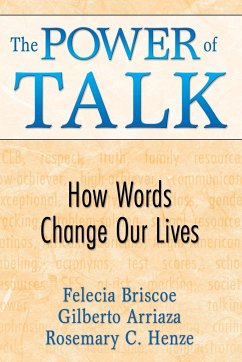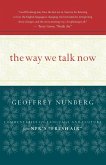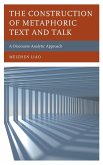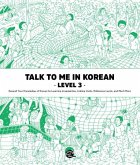- Broschiertes Buch
- Merkliste
- Auf die Merkliste
- Bewerten Bewerten
- Teilen
- Produkt teilen
- Produkterinnerung
- Produkterinnerung
This enlightening book helps educators use everyday language to create more equitable school environments, and offers exercises that strengthen communication and leadership skills.
Andere Kunden interessierten sich auch für
![The Way We Talk Now The Way We Talk Now]() Geoffrey NunbergThe Way We Talk Now14,99 €
Geoffrey NunbergThe Way We Talk Now14,99 €![Claiming Power in Doctor-Patient Talk Claiming Power in Doctor-Patient Talk]() Nancy Ainsworth-VaughnClaiming Power in Doctor-Patient Talk73,99 €
Nancy Ainsworth-VaughnClaiming Power in Doctor-Patient Talk73,99 €![Talk That Counts Talk That Counts]() Ronald K. S. MacaulayTalk That Counts75,99 €
Ronald K. S. MacaulayTalk That Counts75,99 €![Contact Talk Contact Talk]() Contact Talk53,99 €
Contact Talk53,99 €![The Construction of Metaphoric Text and Talk The Construction of Metaphoric Text and Talk]() Meizhen LiaoThe Construction of Metaphoric Text and Talk128,99 €
Meizhen LiaoThe Construction of Metaphoric Text and Talk128,99 €![Talk To Me In Korean - Level 3 Talk To Me In Korean - Level 3]() Talk To Me In Korean - Level 319,99 €
Talk To Me In Korean - Level 319,99 €![Talk To Me In Korean - Level 2 Talk To Me In Korean - Level 2]() Talk To Me In Korean - Level 220,81 €
Talk To Me In Korean - Level 220,81 €-
-
-
This enlightening book helps educators use everyday language to create more equitable school environments, and offers exercises that strengthen communication and leadership skills.
Hinweis: Dieser Artikel kann nur an eine deutsche Lieferadresse ausgeliefert werden.
Hinweis: Dieser Artikel kann nur an eine deutsche Lieferadresse ausgeliefert werden.
Produktdetails
- Produktdetails
- Verlag: Corwin
- Seitenzahl: 200
- Erscheinungstermin: 21. Januar 2009
- Englisch
- Abmessung: 229mm x 152mm x 11mm
- Gewicht: 298g
- ISBN-13: 9781412956024
- ISBN-10: 1412956021
- Artikelnr.: 25434830
- Herstellerkennzeichnung
- Libri GmbH
- Europaallee 1
- 36244 Bad Hersfeld
- gpsr@libri.de
- Verlag: Corwin
- Seitenzahl: 200
- Erscheinungstermin: 21. Januar 2009
- Englisch
- Abmessung: 229mm x 152mm x 11mm
- Gewicht: 298g
- ISBN-13: 9781412956024
- ISBN-10: 1412956021
- Artikelnr.: 25434830
- Herstellerkennzeichnung
- Libri GmbH
- Europaallee 1
- 36244 Bad Hersfeld
- gpsr@libri.de
Felecia M. Briscoe, an associate professor, focuses her research on the relationship between power and knowledge. Her research interests are concerned with the development of educational equity especially as related to classism, racism, and sexism. She studies how power manifests in discourse. Her most recently published article is titled, "Reproduction of Racialized Hierarchies: Ethnic identities in the discourse of educational leadership." She has also just completed a co-authored manuscript in which she analyzes the discourse of the U.S. legislation, "No Child Left Behind." Briscoe has experienced a variety of teaching contexts. She started out as a seventh-grade science teacher in a public school in Las Vegas, Nevada. She also taught at the University of Cincinnati and at Concord College. She has been a member of the Educational Leadership and Policy Studies Department at the University of Texas, San Antonio since the summer of 2000. Briscoe earned her doctorate in educational foundations from the University of Cincinnati. She also has an MA in psychology with an emphasis in experimental cognitive psychology and a BS in elementary education with an emphasis in science from the University of Nevada, Las Vegas.
List of Tables
List of Figures
Acknowledgments
About the Authors
Introduction
Why? The Same Old Problem
What? The Book's Purpose
How? Achieving the Purpose
What Will You Get Out of This Book?
Avoiding the Master's Language Tools
Overview of the Chapters
Where and When Might the Book Be Used?
1. The Power of Language: A Medium for Promoting Social Justice and Equity
In What Ways Is Language a Transformative Force in Society?
What Are Educational Equity and Social Justice
What Are Critical Discourse Analysis and Critical Language Awareness
Conclusion and Summary of Key Points
2. Becoming Effective in Using Critical Language Awareness
Noticing How Language Constructs Our Social World
Relating the Trees to the Forest, and the Forest to the Trees
Imagining Alternatives
Coaching
Teaching With Critical Language Awareness
Using Memorable Examples, Metaphors, and Quotes
Modeling, Teamwork, Inclusiveness, and Respect
Conclusion and Summary of Key Points
3. Avoiding Othering: Practicing Including
Introduction
A Change Agent in Action
How Is Othering Harmful?
Digging Deeper Into Othering
From Othering to Inclusion and Dialogue
Activities
Conclusion and Summary of Key Points
4. Disrupting Prejudice: A Communicative Approach
Introduction
Abstracting
Communicative Model
Developing a Data Culture
Activity: Developing Language Skills for Disrupting Prejudice
Conclusion and Summary of Key Points
5. Exceptionalizing or Democratizing?
Introduction
Exceptionalizing: How It Promotes Inequities
The Importance of Context
Cognitive Disequilibrium and Exceptionalizing
The Context of the Interviews
Recognizing Exceptionalizing Discourse
Revising for a More Democratizing Discourse
Activities for Developing Democratizing Language Skills
Conclusion and Summary of Key Points
6. Recognizing and Revising Stratifying Discourse
Introduction
Key Concepts
Recognizing and Revising Stratifying Discourse
Activities for Developing Language Skills for Social Justice
Conclusion and Summary of Key Points
7. Contesting Labels
Introduction
Contesting Labels
Acronyms as Deep Abstractions
Talk Strategies
Redressing Labels Through Institutional Action
Thoughtful Inaction
Activity: Crowning With Labels
Conclusion and Summary of Key Points
8. Conclusion: The Power of Talk
Revisiting the Book¿s Objectives
Using the Power of Talk for Social Justice
A Final Thought
References
Index
List of Figures
Acknowledgments
About the Authors
Introduction
Why? The Same Old Problem
What? The Book's Purpose
How? Achieving the Purpose
What Will You Get Out of This Book?
Avoiding the Master's Language Tools
Overview of the Chapters
Where and When Might the Book Be Used?
1. The Power of Language: A Medium for Promoting Social Justice and Equity
In What Ways Is Language a Transformative Force in Society?
What Are Educational Equity and Social Justice
What Are Critical Discourse Analysis and Critical Language Awareness
Conclusion and Summary of Key Points
2. Becoming Effective in Using Critical Language Awareness
Noticing How Language Constructs Our Social World
Relating the Trees to the Forest, and the Forest to the Trees
Imagining Alternatives
Coaching
Teaching With Critical Language Awareness
Using Memorable Examples, Metaphors, and Quotes
Modeling, Teamwork, Inclusiveness, and Respect
Conclusion and Summary of Key Points
3. Avoiding Othering: Practicing Including
Introduction
A Change Agent in Action
How Is Othering Harmful?
Digging Deeper Into Othering
From Othering to Inclusion and Dialogue
Activities
Conclusion and Summary of Key Points
4. Disrupting Prejudice: A Communicative Approach
Introduction
Abstracting
Communicative Model
Developing a Data Culture
Activity: Developing Language Skills for Disrupting Prejudice
Conclusion and Summary of Key Points
5. Exceptionalizing or Democratizing?
Introduction
Exceptionalizing: How It Promotes Inequities
The Importance of Context
Cognitive Disequilibrium and Exceptionalizing
The Context of the Interviews
Recognizing Exceptionalizing Discourse
Revising for a More Democratizing Discourse
Activities for Developing Democratizing Language Skills
Conclusion and Summary of Key Points
6. Recognizing and Revising Stratifying Discourse
Introduction
Key Concepts
Recognizing and Revising Stratifying Discourse
Activities for Developing Language Skills for Social Justice
Conclusion and Summary of Key Points
7. Contesting Labels
Introduction
Contesting Labels
Acronyms as Deep Abstractions
Talk Strategies
Redressing Labels Through Institutional Action
Thoughtful Inaction
Activity: Crowning With Labels
Conclusion and Summary of Key Points
8. Conclusion: The Power of Talk
Revisiting the Book¿s Objectives
Using the Power of Talk for Social Justice
A Final Thought
References
Index
List of Tables
List of Figures
Acknowledgments
About the Authors
Introduction
Why? The Same Old Problem
What? The Book's Purpose
How? Achieving the Purpose
What Will You Get Out of This Book?
Avoiding the Master's Language Tools
Overview of the Chapters
Where and When Might the Book Be Used?
1. The Power of Language: A Medium for Promoting Social Justice and Equity
In What Ways Is Language a Transformative Force in Society?
What Are Educational Equity and Social Justice
What Are Critical Discourse Analysis and Critical Language Awareness
Conclusion and Summary of Key Points
2. Becoming Effective in Using Critical Language Awareness
Noticing How Language Constructs Our Social World
Relating the Trees to the Forest, and the Forest to the Trees
Imagining Alternatives
Coaching
Teaching With Critical Language Awareness
Using Memorable Examples, Metaphors, and Quotes
Modeling, Teamwork, Inclusiveness, and Respect
Conclusion and Summary of Key Points
3. Avoiding Othering: Practicing Including
Introduction
A Change Agent in Action
How Is Othering Harmful?
Digging Deeper Into Othering
From Othering to Inclusion and Dialogue
Activities
Conclusion and Summary of Key Points
4. Disrupting Prejudice: A Communicative Approach
Introduction
Abstracting
Communicative Model
Developing a Data Culture
Activity: Developing Language Skills for Disrupting Prejudice
Conclusion and Summary of Key Points
5. Exceptionalizing or Democratizing?
Introduction
Exceptionalizing: How It Promotes Inequities
The Importance of Context
Cognitive Disequilibrium and Exceptionalizing
The Context of the Interviews
Recognizing Exceptionalizing Discourse
Revising for a More Democratizing Discourse
Activities for Developing Democratizing Language Skills
Conclusion and Summary of Key Points
6. Recognizing and Revising Stratifying Discourse
Introduction
Key Concepts
Recognizing and Revising Stratifying Discourse
Activities for Developing Language Skills for Social Justice
Conclusion and Summary of Key Points
7. Contesting Labels
Introduction
Contesting Labels
Acronyms as Deep Abstractions
Talk Strategies
Redressing Labels Through Institutional Action
Thoughtful Inaction
Activity: Crowning With Labels
Conclusion and Summary of Key Points
8. Conclusion: The Power of Talk
Revisiting the Book¿s Objectives
Using the Power of Talk for Social Justice
A Final Thought
References
Index
List of Figures
Acknowledgments
About the Authors
Introduction
Why? The Same Old Problem
What? The Book's Purpose
How? Achieving the Purpose
What Will You Get Out of This Book?
Avoiding the Master's Language Tools
Overview of the Chapters
Where and When Might the Book Be Used?
1. The Power of Language: A Medium for Promoting Social Justice and Equity
In What Ways Is Language a Transformative Force in Society?
What Are Educational Equity and Social Justice
What Are Critical Discourse Analysis and Critical Language Awareness
Conclusion and Summary of Key Points
2. Becoming Effective in Using Critical Language Awareness
Noticing How Language Constructs Our Social World
Relating the Trees to the Forest, and the Forest to the Trees
Imagining Alternatives
Coaching
Teaching With Critical Language Awareness
Using Memorable Examples, Metaphors, and Quotes
Modeling, Teamwork, Inclusiveness, and Respect
Conclusion and Summary of Key Points
3. Avoiding Othering: Practicing Including
Introduction
A Change Agent in Action
How Is Othering Harmful?
Digging Deeper Into Othering
From Othering to Inclusion and Dialogue
Activities
Conclusion and Summary of Key Points
4. Disrupting Prejudice: A Communicative Approach
Introduction
Abstracting
Communicative Model
Developing a Data Culture
Activity: Developing Language Skills for Disrupting Prejudice
Conclusion and Summary of Key Points
5. Exceptionalizing or Democratizing?
Introduction
Exceptionalizing: How It Promotes Inequities
The Importance of Context
Cognitive Disequilibrium and Exceptionalizing
The Context of the Interviews
Recognizing Exceptionalizing Discourse
Revising for a More Democratizing Discourse
Activities for Developing Democratizing Language Skills
Conclusion and Summary of Key Points
6. Recognizing and Revising Stratifying Discourse
Introduction
Key Concepts
Recognizing and Revising Stratifying Discourse
Activities for Developing Language Skills for Social Justice
Conclusion and Summary of Key Points
7. Contesting Labels
Introduction
Contesting Labels
Acronyms as Deep Abstractions
Talk Strategies
Redressing Labels Through Institutional Action
Thoughtful Inaction
Activity: Crowning With Labels
Conclusion and Summary of Key Points
8. Conclusion: The Power of Talk
Revisiting the Book¿s Objectives
Using the Power of Talk for Social Justice
A Final Thought
References
Index








